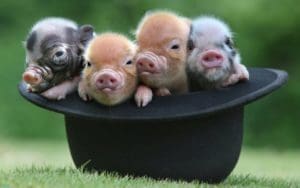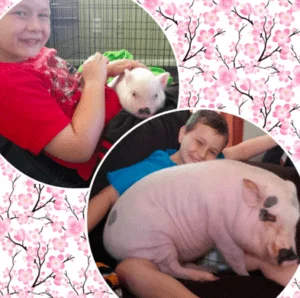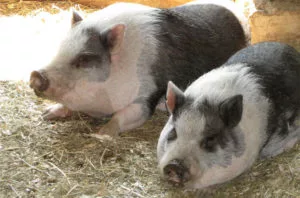
Don’t be fooled, these pigs are only days old!
The Truth about Pot-Bellied Pigs (Sus scrofa domesticus):
Increasingly popular as pets, pot-bellied Pigs are often called Vietnamese or Asian pot-bellied pigs due to their round appearance. They are related to the domestic farm pig and have similar personalities. Even the “teacup” and “micro-mini” pigs can potentially reach adult sizes of 60-200 pounds. They do not reach full mature size until between 3-5 years of age. This is normal but often the reason that rescues and sanctuaries end up full of of “little hooves” as people don’t realize how big they are going to get. They can live up to 12-20 years depending on breeding, diet, and overall health, so this is not a commitment to be taken lightly.
When mature they can become very territorial and aggressive as they try to establish dominance in the household. This is why you should neuter or spay your pig when they are young (between 12 and 16 weeks or before they reach 40 pounds). The larger they become the harder the surgery is on them, and if you wait too long it might be too late to safely perform the surgery at all.
You must pig-proof your home (similar to toddler-, puppy-, parrot-, or ferret-proofing) prior to your new piggy having full access to the house. Training, when firm and consistent, can be very effective for pigs. They respond very well to positive-reinforcement based training since they are usually very food motivated. Set up rules and boundaries much as you would with a dog, but never physically discipline pot-bellied pigs, as it leads to increased aggression and fear-based behaviors. Praise and prevention are much better training tools than punishment.
Although they can be demanding, they do have the advantages of being relatively clean and hypoallergenic, and they are fairly easy to litter- or house-train. Pot-bellied pigs can be headstrong, intelligent, playful, and affectionate animals. They are infamous for learning how to open refrigerators, cabinet doors, run through doors when they hear the treat bag, and generally being inquisitive.
Fat piggies are our fault!
Like us, pigs are omnivores and CONTINUOUSLY hungry! Obesity is common due to their drive to ALWAYS beg for food, even if they have just eaten. They usually fare best when fed measured amounts 2-4 times daily. Monitoring their weight and body condition closely is the only way to know how much to feed them, feed bag recommendations are often too high for the calories they are actually expending. As a general rule pigs that lay around the house should be fed less than active pigs that run around the yard rooting everything up. If they graze outdoors however, their daily ration may need to be cut back a bit. Remember, pigs will always beg and whine for more so appetite is never a good indicator of nutritional status.
Some of the common commercial diets are Mazuri, Heartland, Peak Performance, Nutrena and Manna Pro. Do not offer dog or cat food, as they are not formulated for pot-bellied pigs and often have too much protein and fat. A children’s chewable vitamin can be offered daily and can be used as a morning treat.
Avoid chocolate, table scraps and human junk food as they are often high in fats, protein, and especially salt, which can cause toxicities in pigs. Table scraps can also promote inappropriate begging behavior. Fruits are often high in natural sugars and calories, and therefore should not be fed frequently. Pigs also do not deal well with the acidity in citrus fruits. Corn and potatoes are high in starch, sugar, and carbs that pot-bellied pigs don’t need. Farm-raised pigs are frequently fed corn to promote growth of fat.
Be selective when offering treats; things like Cheerios or unsalted and unbuttered popcorn can be used, but we strongly recommend frozen vegetables like green beans because it takes them longer to chew them and may help prevent dental disease.

Pot-bellied pig before and after – this is the reality of owning (or being owned by) a pot-bellied pig, and it’s not done growing yet!
Inside or outside?
Keeping pot-bellied pigs in the house is hard, but keeping them physically in a yard is harder as they love to root their way under fences. They have very strong noses that can completely elevate fences in their determination to find food, and larger pigs may go right through them! Yards ideally should be enclosed with hog or cattle panels. These can be purchased online or through farm stores such as Rural King and Farm and Fleet. Regardless of the fencing material used, the fence will have to be set deeper into the ground than normal to avoid the pig rooting the fence up. All pigs should be offered an outdoor enclosure, and if kept outside they need a sturdy weatherproof shed area where they can avoid bad weather and temperature extremes.
Indoor pigs can be trained to walk on a harness and get exercise that way, but walking pigs can be challenging as they often like to stop and check for snacks and can respond very poorly to being pulled on a leash. Positive reinforcement training and a pocket full of low-calorie treats can help with this.
Substrates:
Cedar chips and pine chips should be avoided as the aromatic oils can be irritating to their skin as well as their respiratory tract. Blankets are a great substrate for sleeping areas to help them feel cozy and allow them to burrow. Pigs will shred and rearrange their blankets until they have them just perfect! Sleeping bags are not recommended since they can cause overheating. Thicker blankets are a better option for colder days. If living outdoors, straw is an appropriate substrate, piled high enough it offers warmth as well. Pigs are fairly easy to litter-box train so offer newspaper as a substrate in their toileting area.
Keep them cool!
Generally pigs don’t sweat except for the very top end of their nose. Do not leave your pig unattended in areas over 80F. High humidity must also be avoided especially during hot days.
Lots of enrichment = Happy and better-behaved pigs:
Pet pot-bellied pigs become bored easily, especially when kept indoors, and can become destructive. Rooting behavior is instinctual and cannot be stopped but it can be redirected to a specified “rooting area”. Provide a spot in the yard with soft dirt or build a 2’ x 2’ or larger frame in the home that acts as a rooting box. Paper towel, newspaper, and butcher paper can all be crinkled up or laid on top of the toys and treats like Cheerios or pig food to simulate successful rooting outdoors. Grass hay is excellent and provides novel textures and scents.
Toys don’t have to be expensive or elaborate. Simple items like crumpled up newspaper, cardboard boxes, paper towel rolls with newspaper on either end holding in treats, and regular balls are a favorite of many pigs. They will enjoy anything they can tear up, similar to a parrot. Feeding them using a foraging toy that intermittently releases food works well, many of these are made of plastic or hard rubber for dogs and can be used for pigs.
Kiddie pools of clean water outdoors during spring and summer are vital for keeping pot-bellied pigs healthy and entertained. A mud hole a in a section of lawn is excellent for their skin and also to help cool them down. Since they do not sweat they rely heavily on water and mud to cool their bodies.
Pig Grooming Basics:
Pigs don’t require a lot of grooming but there are several things to know. Light skinned pigs will burn in the sun just like a person, so always apply children’s sunscreen especially to the back, ears, and the top of the nose. Their skin is very sensitive will dry out and crack if it is not properly moisturized. A hypoallergenic lotion or even a small amount mineral oil can be used. This is especially important after they are in water. They only need a monthly bath to remove any dirt and help keep the skin in top shape. An oatmeal based organic pet shampoo is best. Daily brushing with a soft bristled brush is recommended.
Remember that pigs are not fond of being held, especially as they become older. As soon as their feet leave the ground they start to panic. They often hate having their hooves trimmed and frequently scream as if they are being harmed when their feet are touched, however this is not a painful procedure. Positive reinforcement training to help them to become adapted to hoof handling may help, but exercise to help keep hooves worn is also important. Tusks may need to be trimmed regularly to prevent overgrowth, but spaying and neutering will significantly reduce the need for this. Lots of ear gunk is normal for pigs, you can clean their ears weekly with a mild dog/cat friendly solution. Warming up the cleansing solution makes it more soothing and helps dissolve ear debris better.

Be prepared, no matter what you are told: your tiny baby pig will easily reach 70 pounds or more!
Helpful tips for the early stages:
– Before bringing your little one home please make sure that you read, read, and read to become familiar with the responsibilities of owning a pot-bellied pig. Consult a minimum of 5 independent sources on their care. A pre-purchase consultation with a knowledgeable veterinarian can save you money and help prevent headaches.
– After you bring your piggy home, if doing well, observe it for 2-3 days then bring it to an exotic veterinarian to have it checked. A physical examination and fecal test for parasites should be done at that time. Deworming medication may be needed.
– Vaccination for rabies after 12 weeks is definitely recommended. Other vaccines such as tetanus and swine erysipelas can also be considered depending on the conditions of your pig’s home.
– Mites are very common in young pigs, who may or may not show symptoms such as scratching and redness on the skin. Veterinarians can test and treat for skin mites very easily at a first appointment.
– Microchipping is also a good idea, as escape is common if your yard or house is not properly pig-proofed.
-Spay or neuter your pig at an EARLY AGE, it will be easier on you and them. It prevents unwanted litters and decreases unwanted smells (urine, feces, scent glands, and body odor) significantly. It also reduces aggressive behaviors (dominance, territoriality, food drive). The longer you wait the riskier the surgery and anesthesia become.
– Get advice from your exotic veterinarian on how to feed them and hopefully prevent them from ever going to a sanctuary. Information from the breeder is often helpful, but we have seen littermates where one gets to be 60 pounds and another to 120 pounds. Some breeders will breed pigs before they are fully mature, so information on the size of the parents may not be an accurate projection if they bred them before the age of 3. Keeping them in good body condition is critical, and often they do not require many calories to do so. However, you want to make sure that their nutrition is adequate and they are not just stunted.
While having a pot-bellied pig can bring a lot of joy, they are not easy pets and should be brought home only after careful research and planning. Whenever considering a pet, always think of the worst case scenario… in this case, 20 years of a 200 pound bulldozer ruling your house!

About Us
Our exotic animal hospital is dedicated exclusively to the care of birds, exotic small mammals, reptiles, and even fish! We can offer everything your pet needs for a healthy and happy life, from wellness care and grooming to diagnostics and dentistry, but we can also provide emergency care during our opening hours, along with more specialized treatment for referred patients.
